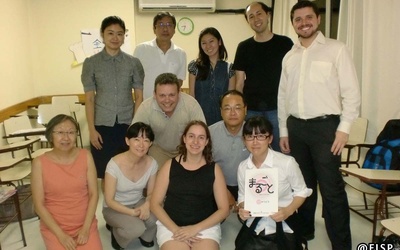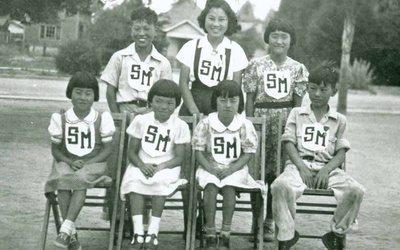Nikkei Chronicles #5—Nikkei-go: The Language of Family, Community, and Culture

Arigato, baka, sushi, benjo, and shoyu—how often have you used these words? In an informal survey conducted in 2010, we found that these were the most frequently used Japanese words among Japanese Americans living in Southern California.
In Nikkei communities around the world, the Japanese language symbolizes the culture of one’s ancestors, or the culture that was left behind. Japanese words often get mixed in with the language of the adopted country, creating a fluid, hybrid way of communicating.
For this series, we asked our Nima-kai community to vote for their favorite stories and an editorial committee to pick their favorites. In total, five favorite stories were selected.
Here are the selected favorite stories.
Editorial Committee’s Selections:
- ENGLISH:
Yokoso Y’all
By Linda Cooper
- JAPANESE:
Brazil is My Second Home — Japan is My Spiritual Home
By Marina Tsustui
- SPANISH:
The Chuo Gakuen School: The Seeds of Prestige for the Japanese Community in Mexico
By Sergio Hernández Galindo
- PORTUGUESE:
Gaijin
By Heriete Setsuko Shimabukuro Takeda
Nima-kai selection:
- 56 stars:
The Japanese language in the daily lives of the members of the Hikari Group of Londrina
By Alba Shioco Hino, Nilza Matiko Iwakura Okano, Kiyomi Nakanishi Yamada
Stories from this series
Mango
Aug. 11, 2016 • Hudson Okada
"Mango? Mango? Mango?" The scene that took place in front of me was quite unusual. It took me a few seconds to understand her: A woman, with a huge question mark over her head, looking at me and saying: “Man-ga? Mango? Mango?". At that moment, I realized that this would be a good opportunity to train my intuition – which was never “there” with these things. I started to raise hypotheses: Despite her Japanese accent and her Japanese appearance, I …
Nihongo comes and goes
July 20, 2016 • Jorge Nagao
Tadatoshi and Setsuko, my parents, arrived in the capital of São Paulo, coming from Vera Cruz, in the interior of São Paulo, in 1955, with 5 children. After a brief stay in a house on the east side, in the district of Ermelino Matarazzo, my father acquired a small grocery store/ mise , nearby. As the customers didn't learn to pronounce their names, Tadatoshi became Mário and Setsuko, Helena. Seu Mário and Dona Helena had to communicate in Portuguese with …
Né?
July 11, 2016 • Hudson Okada
Even though there are many words and expressions that characterize them for Brazilians—hai, banzai, and arigatô—the interjection né [Portuguese-language contraction of não [not] + é [is], meaning “isn’t it?”], of course, is the one that most relates to Japanese. That is evidenced by the fact that there isn’t a single jokester who has never teased a Japanese person, saying things like, “It’s expensive, né?,” “the Japanese have the slanted eye, né?,” and “the Japanese eat raranges, né?”. Note #1: When …
Grasping Grandma’s Japanese Accent—My First Step in Discovering Nikkei-go
July 6, 2016 • Tim Asamen
I live on a farm in the Imperial Valley, which is located in the southeastern corner of California. My Issei grandparents established our farm before the Second World War when thousands of Japanese immigrants converted barren desert into fertile farmland. When I was growing up, my grandmother lived on the farm too, in the original house that my grandparents built in 1930. I can still remember when the house did not yet have an indoor bathroom so there was an …
Chronicles of a Nisei – Memories of a different childhood
June 29, 2016 • Mitsuo Luiz Kariya
The memories that bubble up in my memory, the best, are those from my childhood. My first participation in a theater play at the age of 5, representing the Emperor of Japan, sitting next to my Empress, at Nihongakô. I never forgot. It seemed like he was born for this. To be Emperor. Those were different times. At that age, I went to Japanese school alone, by bus. The driver and the conductor knew me. And they left me at …
Minato Gakuen and Me
June 20, 2016 • Teiko Kaneko
We are excited to ride the train whenever a new route is opened, but often don’t consider the history of the railways and the effort that went into building them. I recently read a story about the history of Minato Gakuen, written by Rio Imamura. Until then, I didn't realize there were many struggles before Minato Gakuen successfully operated. I learned about Minato Gakuen when Japanese classes were still held at Miramar College so it must have been in the …






























